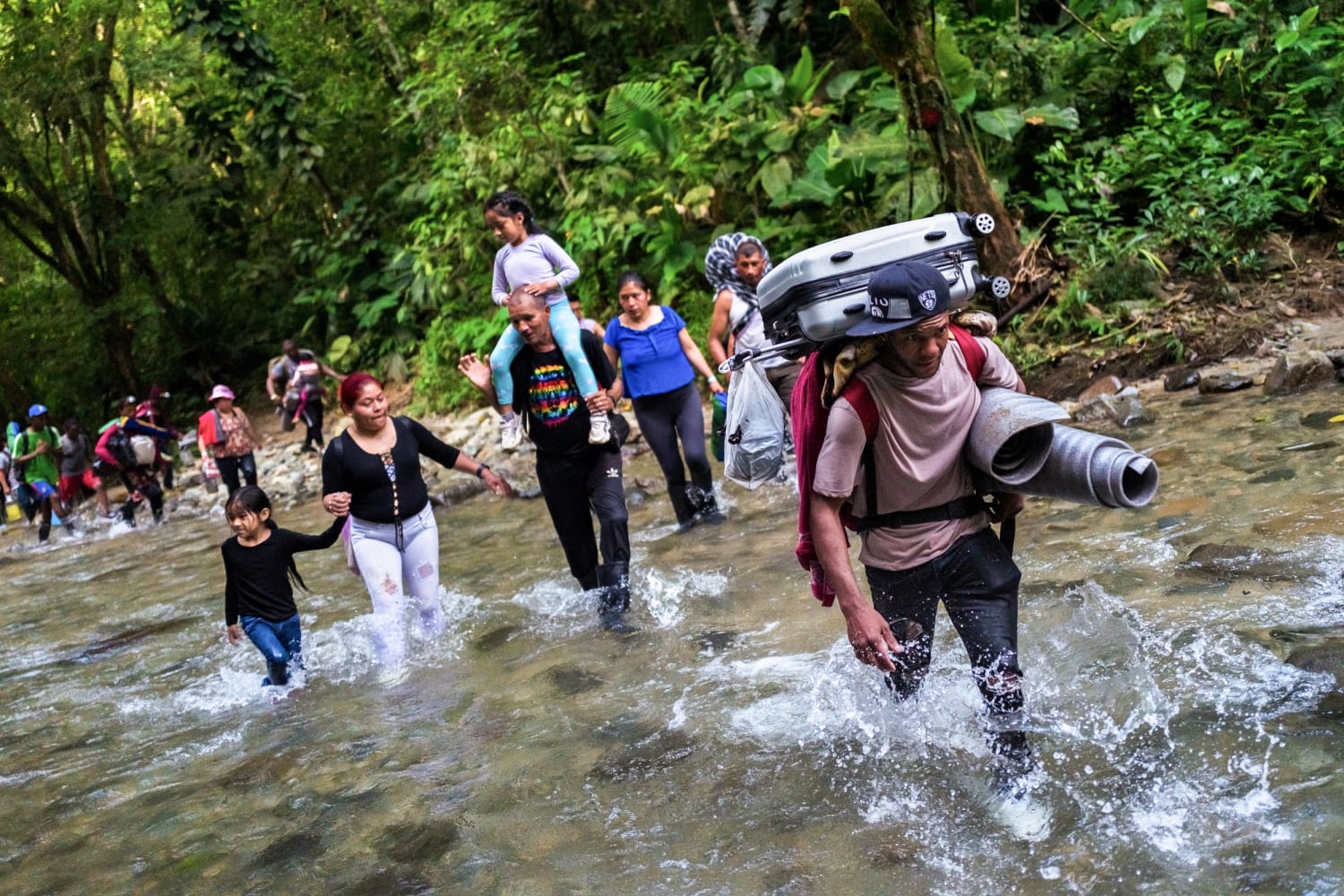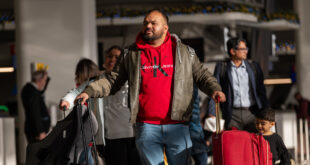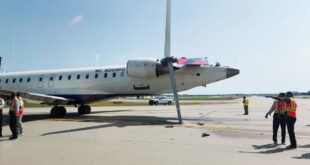

MEXICO CITY — Deep in the Panamanian jungle, Venezuelan migrant Franca Ramirez was scrambling to reach higher ground as a rushing river broke its banks, he said, when something caught his eye: a group of young men, snapping photos of the landscape.
The former police officer, who says he fled imprisonment and torture in Venezuela, was surprised.
They were more than a day’s journey into the Darién Gap. The notorious stretch of jungle in Panama has become a treacherous part of the journey for tens of thousands of people trekking across the Americas, hoping ultimately to reach the United States.
“I asked if they were migrants,” Ramirez said last month, after making it to Mexico. “They said no, that they were creating content and sightseeing in the jungle.”
The encounter was a rare moment of two different worlds colliding in one of the planet’s wildest places.
The jungle has long attracted hard-core adventurers. It is known as the ‘gap’ on Panama’s Darién isthmus because it is the only missing section, running about 60 miles, on the Pan-American highway that stretches from Alaska to Argentina.
For decades, only the most intrepid of travelers ventured into this once impenetrable forest — dodging guerrillas and bandits; hunting for rare orchids or the great green macaw; and seeking the thrill of being one of the few brave enough to enter the wilderness where the road ends.
As adventure tourism has gained popularity worldwide — from climbing Mount Everest to riding a submarine to view the Titanic — tour agencies have also organized group excursions to the remote jungle.
“Tourism has been on the slow burner for decades in the Darien,” said longtime Panamanian tour guide Rick Morales. “The jungle is special because it’s powerful and humbling.”
In recent years, parts of this jungle have become the site of humanitarian catastrophe. Hundreds of thousands of migrants from across the world, including as far as Afghanistan, and parts of Africa, cross the perilous terrain en route to the U.S. border.
Blocked by visa restrictions from entering countries closer to the United States, a quarter of a million people traversed the lawless region last year.
At least 137 migrants died or went missing, including at least 13 minors, according to the U.N.’s International Organization for Migration (IOM).
In addition to its lack of infrastructure, the Darién poses security challenges: the migrant routes in particular are controlled by criminal groups.
“The real number of migrants who have died and disappeared in the jungle is much, much higher,” the IOM said in a statement to Reuters.
Tourists and migrants rarely meet face to face; the routes are almost always separated by dozens of miles. The migration routes hug the Darién’s northern coast on the Caribbean Sea, which offers the most direct path to traverse the roadless jungle. The vast majority of tourism occurs closer to the Pacific Ocean.
Trip advertising does not mention the humanitarian crisis. Depending on the type of trip, tourist packages can range from a few hundred dollars to a few thousand dollars per person for a package that can include medical care, satellite phones, appropriate equipment and a cook.
Marco Wanske, a 31-year-old German who went on a 12-day jungle trek in January, said everyone in his group sustained minor injuries such as “jungle rot,” a fungus that affects the feet, and one person had to be carried out by the group on the last day because she was unable to walk.
Migrants, at the mercy of smuggling gangs, often receive far less for their money.
Kisbel García, a migrant from Venezuela, said she paid over $4,000 to a guide who promised to lead her and her four children and mother-in-law safely through the jungle. But instead of tourist-style protection, García’s guide abandoned them two days into the trek.
The family wandered six days through the mountains, passing corpses as they ran out of food, she says, and relying on scraps of blue cloth tied to trees by migrants to help mark the path for those who followed.
They survived.
“We migrants have to fight against all the risks without any kind of help,” she said. “The Darién is hell.”
Conflicting goals
The global adventure tourism market is booming, experts say, with its expenditures topping $680 billion, according to a 2021 report from the Adventure Travel Trade Association.
Social media has helped fuel the interest in visiting some of the world’s most remote, inaccessible places, as travelers increasingly show off the risk and exclusivity of their journeys through selfies and TikTok videos.
Panama’s government hopes to turn the Darién National Park into “the main eco-tourism destination in Central America,” according to the country’s 2020-2025 master plan for sustainable tourism.
Many naturalists and bird watchers are drawn to the park, which was named a UNESCO World Heritage site in 1981 due to its biodiversity, dramatic scenery and indigenous communities.
Even some migrants recognize the paradox of the jungle’s attractions. “As I traveled, my heart was suffering, but my eyes were in delight,” said Alejandra Peña, from Venezuela, who traversed the jungle with her three children, partner, and elderly parents last year while en route to the U.S. border.
But some humanitarian aid groups have criticized adventure tourism in the Darién, saying marketing trips as if they were a test of survival skills is in bad taste and distracts from the suffering of migrants.
“The Darién is a humanitarian crisis zone, not a place for vacation,” said Luis Eguiluz, who leads Doctors Without Borders (MSF) in Colombia and Panama.
The intersection of these worlds has prompted questions around ethical responsibility, experts say.
“For people who want to go to places that are more wild, what is our obligation?” said Lorri Krebs, an expert on tourism and sustainability at Salem State University in Salem, Massachusetts. “We need standards, we need the ethical or moral components in our tourism endeavors.”
In written responses to Reuters’ questions about the ethics of such tours, the Tourism Ministry defended its efforts to boost international travel to the region, saying Panama “is blessed with sprawling jungles, mighty rivers, mountain peaks, endless coastlines, and diverse cultures.” At the same time, it acknowledged a “catastrophic humanitarian crisis” in a separate part of the Darien due to migration.
Under pressure from the U.S. government, Panama says it has stepped up efforts to stop migrants from crossing the jungle, including a campaign announced with the U.S. in April. Even so, the numbers of migrants in the Darién has continued to rise.
The U.S. State Department tells travelers to not enter a wide swath of the jungle that it says is commonly used by criminals and drug traffickers, and where emergency services are scarce.
Big question mark
Some tourists are already grappling with these kinds of questions.
“The migration crisis in this region was a big question mark for me before the trip,” said German tourist Mark Fischer, who initially worried that the 100-km (62-mile) trek would be like “crossing the Mediterranean sea on a rubber dinghy for fun,” alluding to another part of the world experiencing a migration crisis. His concerns were assuaged when he was told the trail would not overlap the migrants’ route.
From the beaches of Greece to Texas’ Big Bend National Park, which abuts the U.S.-Mexico border, sunbathing and hiking often happen in areas where other people are risking their lives, Morales, the tour guide, said.
But in nearly 25 years of taking people into the Darién, he has never encountered migrants and said he plans his routes to keep these worlds apart.
“Personally, I could not put food in my mouth, or lie in my hammock protected from the elements, knowing that just a few hundred meters down the trail there is a hungry mother and a child spending the night sitting on the bare ground with no shelter from the rain and the insects,” he said.
He added that trekkers often ask how they can help local communities.
Communities profit
Some Indigenous people in the Darién — whose name, according to some experts, derives from the Spanish pronunciation of the original Indigenous name for a local river — rely on tourism to bolster the economies of their local communities.
Travel Darién Panama is an Indigenous-owned tour operator that says on its website it aims to help fund schools and improve living conditions in their village. “We have been living here for decades, and these forests are literally our home,” it says.
The firm’s co-founder, Carmelita Cansari of the Darién’s Embrera community, says part of the company’s aim is to share their way of life: “We offer what we have in our community,” she said. “Caring for nature, our culture, and dance.”
Nina Van Maris, a 32-year-old outdoor enthusiast from Luxembourg, said she was unaware of the migration situation in the Darién when she signed up for an excursion run by German tour operator Wandermut.
She had seen an advertisement on Instagram while recovering from a debilitating rare illness that had left her temporarily unable to walk. The trip became motivation to fully recover.
“I thought to myself: when I can do that, I can do everything,” Van Maris said.
In 2021, she traversed the jungle over ten days, from a village on the Balsas River in the heart of the Darién before ending at the Pacific Ocean.
“When I saw the beach, I thought to myself: I made it. I was crying, it was so emotional for me,” she said. “The jungle gave me my life back.”

 Latest Breaking News Online News Portal
Latest Breaking News Online News Portal




